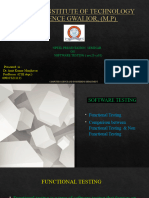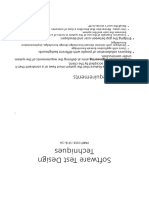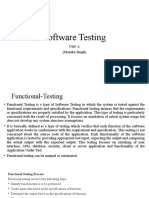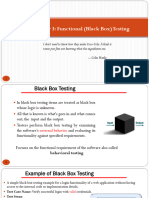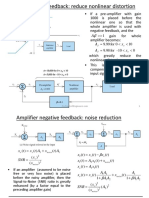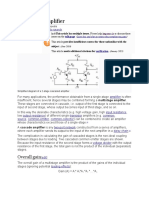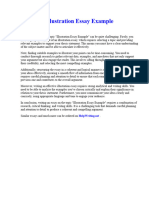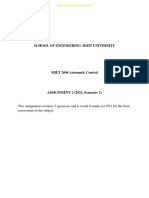Functional Testing
Slide1
�Definition
FUNCTIONAL TESTING
Evaluation of programs based on
functional requirements to ensure the
program works as it was specified to do.
Slide2
�Definition
Slide3
�Definition
A functional test case validates the solution
as defined by the requirements
specification or detailed technical
specification of the component.
A functional test case design is based on
the analysis of the functional specification
of the specific functional component
without reference to its internal workings.
Slide4
�Definition
Functional Testing primarily focuses on ensuring that
the solution components work as designed, and that
the design sufficiently meets the business
requirements. Functional Testing will often involve
some manual steps and stubbing of components as
not all processes will be tightly linked together.
Functional Testing is often the most complex area of
Testing as it involves staggering the test cycle inline
with development as it occurs. Typically, it is also
where there highest degree of changes occur during
the testing process.
Slide5
�Types of Functional Testing Criteria
Types of testing criteria for functional Requirements
Demonstration:
Inspection:
Demonstrate the operation of the function to the system owner to show
that the requirement has been met.
Sometimes used in combination with demonstration, it requires visual
examination of the code documentation, table dumps, scans, etc.
Analysis/Special Qualification:
The processing of accumulated data obtained from other methods, or any
special tools, techniques, procedures, facilities, and acceptable limits. This
type of testing usually affects critical parts of the system and/or interfaces.
Slide6
�Types of Functional Testing Criteria
Demonstration:
Demonstrate the operation of the function to the system
owner to show that the requirement has been met.
Examples:
Test that a screen navigates to the correct next screen
Test that a field is displayed
Test that an inquiry can be made on a database
Slide7
�Types of Functional Testing Criteria
Inspection:
Sometimes used in combination with demonstration, it
requires visual examination of the code documentation,
table dumps, scans, etc.
Examples:
Test that an update is made to a database
Test that a report is in the right format
Test that a database table is created
Slide8
�Types of Functional Testing Criteria
Analysis/Special Qualification:
The processing of accumulated data obtained from other
methods, or any special tools, techniques, procedures,
facilities, and acceptable limits. This type of testing
usually affects critical parts of the system and/or
interfaces.
This is the typical type of testing we think of when we do
functional testing. The types of these tests are
enumerated in the next slide.
Slide9
�Functional Testing Items
Functional Testing will often contain the highest
overall number of test cases, as it is focused on
testing the solution against the following:
Business Rules
Data Mapping
Key Mapping Validation
Data Validation
Filtering
Data Re-Engineering
Derived calculations
Slide10
�Functional TestingDerived Calculations
Functional Requirements
The system shall calculate interest on a daily
basis For a loan given to a producer, the
system will calculate interest daily based on
the prime rate of +1.2
Derived calculations
Slide11
�Functional TestingBusiness Rule
Functional Requirements
The system shall calculate invoice discount
based on customer status. Customers in good
status get a 5% discount, Customers NOT in
good or poor status get a 1% discount.
Customers in poor status get no discount.
Business Rule
Slide12
�Functional TestingData Mapping
Functional Requirements
The system shall create new customer status categories. The
previous categories were good and poor and a null status. The
new categories will be excellent, fair, good and poor. When
converting the data, excellent customers are those customers
who been customers classified as high volume customers and
who have a good status. Good customers who were not
changed to excellent shall remain in the good status. Poor
status is not changed and fair is the previous null status.
Data Mapping
Slide13
�Functional TestingTechniques
Black-box testing includes the following testing
approaches:
Equivalence Partitioning
Boundary Value Analysis
State Transition Testing
Error Guessing
Slide14
�Functional TestingTechniques
Equivalence Partitioning
Equivalence Partitioning is based on evaluation
of business functions by evaluating the input
and/or output data that falls into categories
where the system responds in a similar manner.
Take a look
http://en.wikipedia.org/wiki/Equivalence_partitioning
Slide15
�Functional TestingTechniques
Equivalence Partitioning Process
Look at functions that require input
Select input and output data that is representative of
all other data that would likely invoke the same
process for that particular condition.
These should include
All valid input/output data for a given condition
All invalid input/output data
Slide16
�Functional TestingTechniques
Equivalence Partitioning Example
If a business rule stated that discounts were
given to senior citizens (over 62) of 5%.
We would have test cases such as
One person over 62
(all others over in this equivalence class)
One person under 62
(all others over in this equivalence class)
Slide17
�Functional TestingTechniques
Boundary Value Analysis
The purpose of boundary value testing is to
evaluated a functions based on the boundaries of
conditions.
Take a look
http://en.wikipedia.org/wiki/Boundary_value_analysis
Slide18
�Functional TestingTechniques
Boundary Value Process
Look at functions that require
selection based on specific values.
Select input data that is
representative of the boundary
values.
Slide19
�Functional TestingTechniques
Boundary Value Example
If a business rule stated that
discounts were given to senior
citizens (over 62) of 5%.
We would have a test cases for
One person who is 62
Slide20
�Functional TestingTechniques
Error Guessing
The purpose of error guessing is to focus the
testing activity on areas that have not been
handled by the other more formal techniques,
such as equivalence partitioning and
boundary value analysis. Error guessing is
the process of making an educated guess as
to other types of areas to be tested.
Slide21
�Functional TestingTechniques
Error Guessing
Examples of areas where error guessing
might be used:
initialization of data,
wrong kind of data, (e.g., negative numbers, nonnumeric versus numeric),
restart/recovery
proper handling of concurrent processes
Slide22
�Functional TestingTechniques
State Transition Testing
State transition testing focuses on the testing of
transitions from one state (e.g., open, closed) of
an object (e.g., an account) to another state. A
good technique to test screen navigation.
Take a look
http://en.wikipedia.org/wiki/State_transition_table
Slide23
�Good Reference
Center for Software Testing Education & Research
At FIT
http://www.testingeducation.org/BBST/index.html
John McGreggor known software testing
researcher
http://www.cs.clemson.edu/~johnmc/columns.html
Slide24




